« July 2006 | Main | September 2006 »
August 16, 2006
Porphyria Cutanea Tarda
DISEASE OVERVIEW
• Porphyrias: a group of diseases caused by inborn enzymatic defects in the heme biosynthetic pathway
• Most common type of porphyria is PCT
• PCT results from a deficiency of hepatic uroporphyrinogen decarboxylase activity
• Acquired and Familial forms exist
o Acquired PCT: most often precipitated by alcohol, Estrogens, oral contraceptives, certain environmental pollutants, and iron overloading with accompanying genetic factors
o Familial PCT: autosomal dominant
• Aside: PCT has been suggested in some of the vampire and werewolf legends, hence the character below
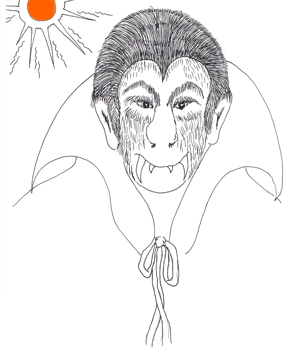
SIGNS and SYMPTOMS
• Blistering in sun exposed areas (caused by the generation of peroxide by the UV excited porphyrins)
• Increased skin fragility
• Facial hypertrichosis (see all figures)
• Hyperpigmentation
• Sclerodermoid changes
• Dystrophic calcification with ulceration
DIAGNOSIS
• “Port-wine urine”: red-brown discoloration due to high levels of porphyrin pigments
• Urine with a bright pink fluorescence under a Wood's light
• Elevated urine uroporphyrin: coproporhyrin ratio- a ratio of 4:1 or more
• Quantitative assays of the various porphyrins must be performed to obtain a reliable diagnosis
• Biopsy specimens for direct immunofluorescence are taken from the edge of lesions
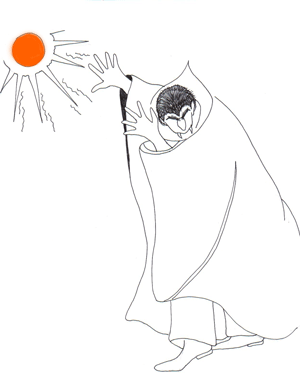
TREATMENT
• Phlebotomy: iron removal because iron overload is one of the triggers of the disease. One unit of blood should be removed every 2 to 4 weeks until the hemoglobin drops to 10mirogm/dl or until the serum iron drops to 50micromg/dl.
Posted by mmw at 10:34 PM | Comments (0)
August 11, 2006
Cholesterol lowering drugs
Cholesterol treatment guidlines:
Current guidelines for cholesterol treatment: http://www.nhlbi.nih.gov/guidelines/cholesterol/profmats.htm
Drug Treatment:
There are four major classes of medications are used to treat hyperlipidemia:
o HMG-CoA reductase inhibitors (statins)
o Bile acid sequestrants (cholestyramine, cholestipol)
o Nicotinic acid
o Fibric acids
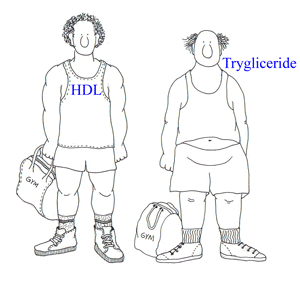
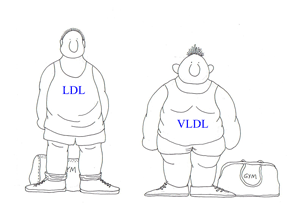
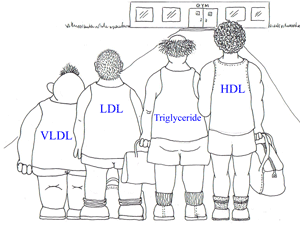
o The statins can lower LDL levels by 18% to 55% and triglyceride levels by 7% to 30%. They also can raise HDL levels by 5% to 15%.Their major side effects include myopathy and an elevation of liver enzyme levels.
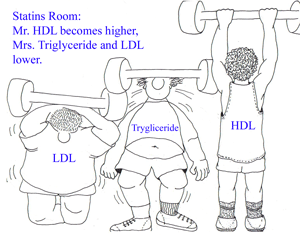
o The bile acid resins (cholestyramine, cholestipol) lower LDL levels by 15% to 30%, and raise HDL levels by 3% to 5%. They have no effect on triglyceride levels. Their major side effects include gastrointestinal distress, constipation, and a decrease in the absorption of other drugs.
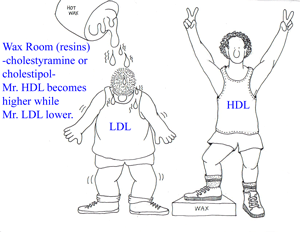
o Nicotinic acid lowers LDL levels by 5% to 25% and triglyceride levels by 20% to 50%. Nicotinic acid also raises HDL levels by 15% to 35%. The major side effects of nicotinic acid include flushing, hyperglycemia, hyperuricemia, GI distress, and hepatotoxicity.
o Fibric acids lower LDL levels by 5% to 20% and triglyceride levels by 20% to 50%, and raise HDL levels by 10% to 20%. Their major side effects include dyspepsia, gallstones, myopathy, and unexplained noncardiac death.
Posted by mmw at 09:39 PM | Comments (0)